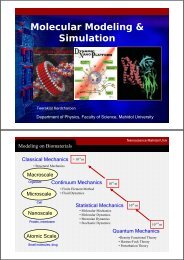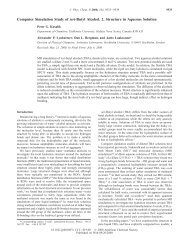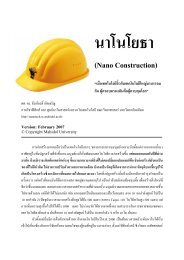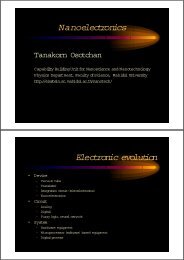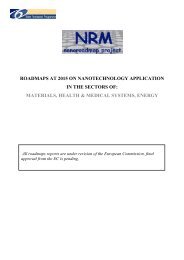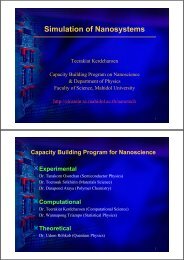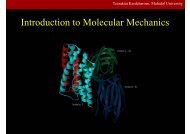SIMPLIFIED INTRODUCTION TO AB INITIO BASIS ... - Nano Mahidol
SIMPLIFIED INTRODUCTION TO AB INITIO BASIS ... - Nano Mahidol
SIMPLIFIED INTRODUCTION TO AB INITIO BASIS ... - Nano Mahidol
Create successful ePaper yourself
Turn your PDF publications into a flip-book with our unique Google optimized e-Paper software.
<strong>SIMPLIFIED</strong> <strong>INTRODUCTION</strong> <strong>TO</strong> <strong>AB</strong> <strong>INITIO</strong><strong>BASIS</strong> SETS. TERMS AND NOTATION.Jan K. Labanowski, Ohio Supercomputer Center,1224 Kinnear Rd., Columbus, OH 43212-1163,E-mail: jkl@osc.edu, JKL@OHSTPY.BITNETPermission is granted to do whatever you wish with this.<strong>INTRODUCTION</strong>Some straightforward reviews on basis sets are available: (Ahlrich&Taylor,1981), (Andzelm et al., 1984), (Dunning & Hay, 1977), (Feller & Davidson,1986), (Feller & Davidson, 1990), (Poirier et al., 1985).Historically, the quantum calculations for molecules were performed asLCAO MO, i.e. Linear Combination of Atomic Orbitals - Molecular Orbitals.This means that molecular orbitals are formed as a linear combination ofatomic orbitals:i =nX=1c i where i is the i-th molecular orbital, c i are the coecients of linearcombination, mu is the -th atomic orbital, and n is the number of atomicorbitals.Strictly speaking, Atomic Orbitals (AO) are solutions of the Hartree-Fock equations for the atom, i.e. a wave functions for a single electron in theatom. Anything else is not really an atomic orbital. Some things are similarthough, and there is a lot of confusion in the terminology used. Later on, theterm atomic orbital was replaced by \basis function" or \contraction," whenappropriate. Early, the Slater Type Orbitals (S<strong>TO</strong>'s) were used as basisfunctions due to their similarity to atomic orbitals of the hydrogen atom.They are described by the function depending on spherical coordinates: i ( n l m r)=Nr n;1 e ;r Y lm ( )1
where N is a normalization constant, is called \exponent". The r, ,and are spherical coordinates, and Y lm is the angular momentum part (functiondescribing \shape"). The n, l, and m are quantum numbers: principal,angular momentum, and magnetic respectively.Unfortunately, functions of this kind are not suitable for fast calculationsof necessary two-electron integrals. That is why, the Gaussian Type Orbitals(G<strong>TO</strong>s) were introduced. You can approximate the shape of the S<strong>TO</strong>function by summing up a number of G<strong>TO</strong>s with dierent exponents andcoecients. Even if you use ten G<strong>TO</strong>'s to represent S<strong>TO</strong>, you will still calculateyour integrals much faster than if original S<strong>TO</strong>s are used. The G<strong>TO</strong>(called also cartesian gaussian) is expressed as:g( l m n x y z)=Ne ;r2 x l y m z nwhere N is a normalization constant, is called \exponent". The x, y,andz are cartesian coordinates. The l, m, and n are not quantum numbersbut simply integral exponents at cartesian coordinates. r 2 = x 2 + y 2 + z 2 .Calling gaussians G<strong>TO</strong>s is probably a misnomer, since they are not reallyorbitals. They are simpler functions. In recent literature, they are frequentlycalled gaussian primitives. The main dierence is that r n;1 , the preexponentialfactor, is dropped, the r in the exponential function is squared, andangular momentum part is a simple function of cartesian coordinates. Theabsence of r n;1 factor restricts single gaussian primitive to approximatingonly 1s, 2p, 3d, 4f ... orbitals. It was done for practical reasons, namely, forfast integral calculations. However, combinations of gaussians are able to approximatecorrect nodal properties of atomic orbitals if primitives are takenwith dierent signs (see examples later in this text). Following cartesiangaussian functions are possible:1s = Ne ;r22p x = Ne ;r2 x2p y = Ne ;r2 y2p z = Ne ;r2 z3d xx = Ne ;r2 x 23d xy = Ne ;r2 xy2
3d xz = Ne ;r2 xz3d yy = Ne ;r2 y 23d yz = Ne ;r2 yz3d zz = Ne ;r2 z 24f xxx = Ne ;r2 x 34f xxy = Ne ;r2 x 2 y4f xyz = Ne ;r2 xyzetc.Sometimes, the so-called scale factor, f, is used to scale all exponents inthe related gaussians. In this case, the gaussian function is written as:g( l m n f x y z)=Ne ;f 2 r 2 x l y m z nBe careful not to confuse it with \f" for the f-orbital.The sum of exponents at cartesian coordinates, L = l + m + n, isusedanalogously to the angular momentum quantum number for atoms, to markfunctions as s-type (L=0), p-type (L=1), d-type (L=2), f-type (L=3), etc.There is a problem with d-type and higher functions. There are only 5linearly independent and orthogonal d orbitals, while there are 6 possiblecartesian gaussians. If we use all six, we are also introducing a 3s typefunction since:3d xx +3d yy +3d zz = N(x 2 + y 2 + z 2 )e ;r2 = Nr 2 e ;r2 =3sMore recently, this eect was studied for sulphur by (Sapio & Topiol,1989).Examination of f-type functions shows that there are 10 possible cartesiangaussians, which introduce 4p x ,4p y and 4p z type contamination. However,there are only 7 linearly independent f-type functions. This is a majorheadache since some programs remove these spurious functions and some donot. Of course, the results obtained with all possible cartesian gaussians willbe dierent from those obtained with a reduced set.3
HOW ARE THESE GAUSSIAN PRIMITIVES DE-RIVED?Gaussian primitives are usually obtained from quantum calculations onatoms (i.e. Hartree-Fock or Hartree-Fock plus some correlated calculations,e.g. CI). Typically, the exponents are varied until the lowest total energy ofthe atom is achieved (Clementi et al., 1990). In some cases, the exponents areoptimized independently. In others, the exponents are related to each otherby some equation, and parameters in this equation are optimized (e.g. eventemperedor \geometrical" and well-tempered basis sets). The primitives soderived describe isolated atoms and cannot accurately describe deformationsof atomic orbitals brought by the presence of other atoms in the molecule.Basis sets for molecular calculations are therefore frequently augmented withother functions which will be discussed later.For molecular calculations, these gaussian primitives have tobecontracted,i.e., certain linear combinations of them will be used as basis functions.The term contraction means \a linear combination of gaussian primitivesto be used as a basis function." Such a basis function will have itscoecients and exponents xed. The contractions are sometimes called ContractedGaussian Type Orbitals (CG<strong>TO</strong>). To clear things up, a simple examplefrom Szabo and Ostlund, 1989. The coecients and exponents ofGaussian expansion which minimizes energy of the hydrogen atom were derivedby Huzinaga, 1965. Four s-type gaussians were used to represent 1sorbital of hydrogen as:1s = 0:50907N 1 e ;0:123317r2 +0:47449N 2 e ;0:453757r2 +0:13424N 3 e ;2:01330r2 +0:01906N 4 e ;13:3615r2 (1)N i is a normalization constant foragiven primitive. In the case of gaussiansof type s it is equal to (2=) 3=4 .These primitives may be grouped in 2 contractions. The rst contractioncontains only 1 primitive: 1 = N 1 e ;0:123317r23 primitives are present in the second contraction: 2 = N[0:47449N 2 e ;0:453757r2 +0:13424N 3 e ;2:01330r2 +0:01906N 4 e ;13:3615r2 ]4
N is a normalization constant for the whole contraction.In this case, 4 primitives were contracted to 2 basis functions. It is frequentlydenoted as (4s) ! [2s] contraction (some use (4s)/[2s] notation). Thecoecients in function 2 are then xed in subsequent molecular calculations.The way inwhich contractions are derived is not easy to summarize.Moreover, it depends upon the intended use for the basis functions. It is agood idea to always read the original paper which describes the way inwhichcontractions have been done. Some basis sets are good for geometry and energies,some are aimed at properties (e.g. polarizability), some are optimizedonly with Hartree-Fock in mind, and some are tailored for correlated calculations.Finally, some are good for anions and other for cations and neutralmolecules. For some calculations, a good representation of the inner (core)orbitals is necessary (e.g. for properties required to analyze NMR spectrum),while other require best possible representation of valence electrons.WHY ARE CONTRACTIONS DONEObviously, the best results could be obtained if all coecients in gaussianexpansion were allowed to vary during molecular calculations. Moreover,the computational eort (i.e. \CPU time") for calculating integrals in theHartree-Fock procedure depends upon the 4th power in the number of gaussianprimitives. However, all subsequent steps depend upon the number ofbasis functions (i.e. contractions). Also, the storage required for integrals(when Direct SCF is not used) is proportional to the number of basis functions(not primitives!). Frequently the disk storage and not the CPU timeis a limiting factor. The CPU time requirements are more acute when post-Hartree- Fock (e.g. correlated methods) are used, since the dependence uponthe number of basis functions here is more steep than the 4th power.There are two basic forms of contractions, namely \segmented" and \general".The segmented contractions are disjointed, i.e., given primitive appearsonly in one contraction. The example given above (4s)! [2s] is a segmentedcontraction. Occasionally, one or two primitives may appear in more thanone contraction, but this is an exception to the rule. The general contractions,on the contrary, allow each of the primitives to appear in each basisfunction (contraction). The segmented contractions are far more popular andwill be described rst. The reason for their popularity is not that they are5
etter, but simply, that the most popular ab initio packages do not implementecient integral calculations with general contractions. The computercode to perform integral calculations with general contractions is muchmorecomplex than that for the segmented case.SEGMENTED CONTRACTIONS. TERMS AND NO-TATIONThe segmented basis sets are usually structured in such away that themost diuse primitives (primitives with the smallest exponent) are left uncontracted(i.e. one primitive per basis function). More compact primitives (i.e.those with larger exponents) are taken with their coecients from atomicHartree-Fock calculations and one or more contractions are formed. Thenthe contractions are renormalized. Sometimes dierent contractions shareone or two functions (the most diuse function(s) from the rst contractionenters the next one).Cartesian gaussians are grouped in shells corresponding to the same valueof angular momentum quantum number. Of course, these shells should not beconfused with electron shells (i.e. electrons with the same principal quantumnumber: K ! n=1, L ! n=2, etc.). Quantum chemists must have run outof words on this one. And hence, we have s-shell, p-shell, d-shell, f-shell,g-shell, etc. The shell is a collection of cartesian gaussians that have thesame L (see denition of cartesian gaussian above). Thus, the s-shell is acollection of s type gaussians p-shell is a collection of p-type gaussians d-shell is a collection of d-type gaussians and so on. Of course, combiningprimitives belonging to dierent shells within the same contraction does notmake sense because primitives from dierent shells are orthogonal.But even here there is a room for more confusion. Many basis sets usethe same exponents for functions corresponding to the same principal quantumnumber, i.e., electronic shell. S<strong>TO</strong>-3G is an example, as well as otherbasis sets from Pople's group. Atoms of the rst and second row (i.e. Li -Ne, Na - Cl) have the same exponents for s- and p-type gaussians formallyassociated with a given electron shell of the isolated atom. For the basis setsin which s- and p-type functions share the same exponents, the term SP-shellis used. Sometimes term L-shell is used by analogy to the 2nd electron shell.This approximation works very well in practice. Moreover, it is possible to6
write ecient code for calculating integrals for such case. It is important tostress here that the distinction between inner orbitals and valence orbitals iskind of arbitrary and lingers from the past era of Slater orbitals. Contractionsconsisting of primitives with large exponents are associated with inneratomic orbitals while more diuse fuctions are allied with valence orbitals.Basis functions are not usually atomic orbitals, and in many cases, they donot even resemble orbitals of isolated atoms. In fact, examining coecientsof molecular orbitals frequently reveals that these \core" basis functions contributesubstantially to the Highest Occupied Molecular Orbital (HOMO). Itis a consequence of the fact that basis functions on a given center are usuallynot orthogonal to each other. Also \core" basis functions on dierent centersare not really compact and overlap to a great extent with \core" functions onneighbor centers { situation not likely to occur with true atomic core orbitals.The early gaussian contractions were obtained by a least square t toSlater atomic orbitals. The number of contractions (not primitives!) usedfor representing a single Slater atomic orbital (i.e. zeta, ) was a measure ofthe goodness of the set. From this era we have terms like single zeta (SZ),double zeta (DZ), triple zeta (TZ), quadruple zeta (QZ), etc. In the minimalbasis set (i.e. SZ) only one basis function (contraction) per Slater atomicorbital is used. DZ sets have two basis functions per orbital, etc. Sincevalence orbitals of atoms are more aected by forming a bond than the inner(core) orbitals, more basis functions should be assigned to describe valenceorbitals. This prompted development of split-valence (SV) basis sets, i.e.,basis sets in which more contractions are used to describe valence orbitalsthan core orbitals. That more basis functions are assigned to valence orbitalsdoes not mean the valence orbitals incorporate more primitives. Frequently,the core orbitals are long contractions consisting of many primitive gaussiansto represent well the \cusp" of s type function at the position of the nucleus.The \zeta" terminology is often augmented with a number of polarizationfunctions which will be described later. So, DZP means double-zeta pluspolarization, TZP stands for triple-zeta plus polarization, etc. Sometimesthe number of polarization functions is given, e.g. TZDP, TZ2P, TZ+2Pstands for triple-zeta plus double polarization. Letter V denotes split valencebasis sets, e.g., DZV represents basis set with only one contraction for innerorbitals, and two contractions for valence orbitals. The creativity hereisenormous and spontaneous.The minimal basis set is the smallest possible set, i.e., it contains only one7
function per occupied atomic orbital in the ground state. Actually, italwaysincludes all orbitals from partially occupied subshells and valence p-typefunctions for elements from the rst 2 groups of the periodic table. So for Liand Be atoms it has 2 s-type contractions and 1 p-type contraction. Minimalbasis set for S atom has 3 s-type contractions and 2 p-type contractions. Themost popular minimal basis sets are the S<strong>TO</strong>-nG, where n denotes number ofprimitives in the contraction. These sets were obtained by the least square tof the combination of n gaussian functions to a Slater type orbital of the sametype with =1:0, For this set additional constraint is used, that exponents ofcorresponding gaussian primitives are the same for basis functions describingorbitals with the same principal quantum number (e.g. the same primitivesare used for 2s and 2p function). Then, these exponents are multipled by thesquare of zeta in the Slater orbital which described best the set of molecules.For details, see Szabo and Ostlund (1989) or original literature quoted onpage 71 of Hehre et al. (1986). The S<strong>TO</strong>-3G (i.e. 3 primitives per eachSlater type function) is the most widely used set.For other sets a more complicated notation needs to be used to specify thenumber of primitives and contractions explicitly. The parentheses () embracethe number of primitives that are given in the order of angular momentumquantum number. Square brackets [] are used to specify the number of resultingcontractions. For example: (12s,9p,1d) means 12 primitives on s-shell, 9primitives on p-shell, and 1 primitive on d-shell. This is sometimes abbreviatedeven further by skipping the shell symbols (12,9,1). The [5,4,1] meansthat s-shell has 5 contractions, p-shell has 4 contractions and d-shell has 1contraction. To denote how contractions were performed, the following notationis frequently used: (12,9,1) ! [5,4,1] or (12,9,1)/[5,4,1] or (12s,9p,1d)! [5s,4p,1d]. This means that 12 s-type primitives were contracted to form5s-type contractions, 9 p-primitives were contracted to 4 basis functions and1 d-primitive was used as a basis function by itself. Note of caution here.The statement \9 p-primitiveswere contracted to 4 basis functions" actuallymeans that 12 basis functions were created. Each p-type basis function has3variants: p x , p y ,andp z which dier in their cartesian part (i.e., angularpart). The same is true for d-, f-, and higher angular momentum functions.The notation above does not say howmany primitives are used in eachcontraction. The more elaborate notation explicitly lists the number of primitivesin eachcontraction. For example: (63111,4311,1) means that there are 5s-type contractions consisting of 6, 3, 1, 1 and 1 primitives, respectively. The8
p-shell consists of 4 basis functions with 4, 3, 1 and 1 primitives, and d-shellhas 1 uncontracted primitive. Sometimes slashes are used instead of commas:(63111/4311/1). This is sometimes \abbreviated" to (633x1,432x1,1). Thereis also another notation to denote contractions as L(i/j/k/l...) for each shellcorresponding to angular momentum quantum number equal to L. For example,the (63111,4311,1) basis set is represented as: s(6/3/1/1/1), p(4/3/1/1),and d(1). Of course, variants of this notation are also used. You can ndthis set written as: (6s,3s,1s,1s,1s/4p,3p,1p,1p/1d) or (6,6,1,1,1/4,3,1,1/1)or [6s,3s,1s,1s,1s/4p,3p,1p,1p/1d] (sic!). I did not study the combinatorics ofthis, but quantum chemists might have exhausted all combinations of digits,brackets and commas. However, if you ask 10 quantum chemists whichnotation is considered standard, you will get 20 dierent answers.Sometimes the same primitive is incorporated in two contractions (i.e.is \doubled") e.g., the popular Chandler-McLean (12,9) sulphur basis set(McLean and Chandler, 1980) is contracted as [6,5] with the scheme (631111,42111). If you count primitives contained in contractions for the s-shell, youget 13 primitives instead of 12. This means that one primitive is shared(i.e. doubled) between two contractions, 6- and 3-contraction in this case.It would make little sense to share a primitive between 6- and 1- or 3- and1-contrac- tion since such contraction would yield the basis set of the samequality as \undoubled" one. In many cases the smallest exponent fromtherst contraction is repeated in the next contraction as the largest one. In theabove case, the basis set formally represents a general contraction, but sinceonly one function is doubled, this set is used frequently in programs that donot support general contractions.By convention, the primitives are listed as exponents and coecientsstarting from the highest exponent. In tables of exponents and coecientsthe numbers are frequently represented in an interesting way, with powers of10 in parentheses, e.g. 457.3695 is denoted as 4.573696(+2) and 0.01403732as 1.403732(-2). Of course, it is obvious if you know it. The typical basis setspecication (Gordon, 1980, modied) is given below as an example:In the example above, corresponding exponents for s- and p-type contractionsare equal but coecients in s- and p-type contractions are dierent.Gaussian primitives are normalized here since coecients for basis functionsconsisting of one primitive (last row) are exactly 1.0. The basis set aboverepresents the following contraction (16s,10p) ! [4s,3p] or (6631,631).To add to the confusion, the coecients are sometimes listed either as9
Table 1: 66-31G basis set for silicon.Shell Exponent s coecient p coecient1S 1.61921(+4) 1.94924(-3)2.43609(+3) 1.48559(-2)5.56001(+2) 7.25689(-2)1.56813(+2) 2.45655(-1)5.01692(+1) 4.86060(-1)1.70300(+1) 3.25720(-1)2SP 2.93350(+2) -2.82991(-3) 4.43334(-3)7.01173(+1) -3.60737(-2) 3.24402(-2)2.24301(+1) -1.16808(-1) 1.33719(-1)8.19425 9.35768(-2) 3.26780(-1)3.14768 6.01705(-1) 4.51139(-1)1.21515 4.22207(-1) 2.64105(-1)3SP 1.65370 -2.40600(-1) -1.51774(-2)5.40760(-1) 7.37953(-2) 2.75139(-2)2.04406(-1) 1.04094 7.83008(-1)3SP 7.23837(-2) 1.00000 1.0000010
original coecients in atomic orbitals or are renormalized for the given contraction.In some cases coecients are premultiplied by a normalizationconstant for a gaussian primitive, but in most cases it is assumed thatg( l m n x y z) is already normalized (and this is the correct way!). Youhave to be prepared for surprises when entering explicit basis sets from theliterature. Program manuals neglect basis sets description assuming it iscommon knowledge. When specifying structure of the basis sets for the entiremolecule, slashes are used to separate information for dierent atoms(or rows, if basis sets for a given row have the same structure for all atoms).The information is given starting from the heaviest atoms. For example, thebasis set for water would be given as (10s,5p,1d/5s,1p) ! [4s,2p,1d/2s,1p]in which case the contractions for oxygen atoms are (10,5p,1d) ! [4s,2p,1d]and for the hydrogen (5s,1p) ! [2s,1p].Pople's basis setsA dierent convention was adopted byPople and coworkers. The basis setstructure is given for the whole molecule, rather than particular atom. Thisnotation emphasizes also a split valence (SV) nature of these sets. Symbolslike n-ijG or n-ijkG can be encoded as: n-number of primitives fortheinner shells ij or ijk - number of primitives for contractions in the valenceshell. The ij notations describes sets of valence double zeta quality and ijksets of valence triple zeta quality. Generally, in basis sets derived by Pople'sgroup, the s and p contractions belonging to the same \electron shell" (i.e.corresponding formally to the same principal quantum number n) are foldedinto a sp-shell. In this case, number of s-type and p-type primitives is thesame, and they have identical exponents. However, the coecients for s- andp-type contractions are dierent.Now, some examples. The 4-31G basis set for hydrogen (hydrogen hasonly valence electrons!) is a contraction (31) or (4s) ! [2s] for rst row atoms(8s,4p) ! [3s,2p] or (431,31) and for 2nd row atoms the contraction schemeis (12s,8p) ! [4s,3p] or (4431,431). For water molecule, these contractionscould be encoded as (431,31/31). The 6-311G set represents the followingcontractions for water (6311,311)/(311) or (11s,5p/5s) ! [4s,3p/3s].The Pople's basis sets can also be augmented with d type polarizationfunctions on heavy atoms only (n-ijG*or n-ijkG*) or on all atoms, withp-functions on hydrogens (n-ijG** or n-ijkG**). In methane, the 4-31G*encodes the following split (431,31,1)/(31) or (8s,4p,1d/4s)![3s,2p,1d/2s],while 6-311G** for HCN molecule would involve the following contractions:11
(6311,311,1)/(311,1) or (11s,5p,1d/5s,1p) ! [4s,3p,1d/3s,1p]. Currently, the6-311G keyword for second row atoms,asimplemented in Gaussian90 program,does not actually correspond to the true 6-311G set. It is explicitlymentioned in Gaussian90 manual. For these atoms, 6-311G keyword defaultsto MC basis sets (McLean and Chandler, 1980) of the type (12s,9p) ! [6,5]with contraction scheme (631111,42111). Note, that one of the s-type functionsis doubled. The basis sets for P, S and Cl correspond actually to the\anion" basis sets in the original paper since \these were deemed to givebetter results for neutral molecules as well."Sometimes, for atoms of the second row nm-ijG notation is used. Forexample, 66-31G means that there is: 1 function containing 6 primitives on the innermost s-shell, 1 set of functions belonging to the inner SP-shell (i.e. 2SP shell), eachconsisting of 6 gaussian primitives (i.e. 1 s-type function and p x , p y ,p z functions consisting of 6 primitives with the same exponents). Notethough that coecientsinsandptype contractions are dierent, 2 sets of SP functions for valence SP shell (one set consisting of contractionswith 3 primitives and the other with 1 primitive).It is possible to write this as (16s,10p) ! [4s,3p] or in more detail as (6631,631)contraction scheme or alternatively as s(6/6/3/1), p(6/3/1).Polarization and diuse functionsThe original contractions derived from atomic Hartree-Fock calculationsare frequently augmented with other functions. The most popular are thepolarization and diuse functions. The polarization functions are simplyfunctions having higher values of L than those present in occupied atomicorbitals for the corresponding atom. At least for me, there is some ambiguityhere, since for lithium, the p-type functions are not considered polarizationfunctions, while for sulphur, the d-functions are considered polarization functions.In both cases these orbitals are not populated in the ground electronicstate of the atom. The reason for including p-type functions in the Li andBe atoms, even in the minimal basis sets, is prac- tical, however. Withoutthese functions, the results are extremely poor. The reason for not includingd-type functions for sulphur should be the same as for other atoms, i.e., youcan obtain reasonable results without them. I wish, I could believe that.12
The exponents for polarization functions cannot be derived from Hartree-Fock calculations for the atom, since they are not populated. However, theycan be estimated from correlated calculations involving atoms. In practice,however, these exponents are estimated \using well established rules of thumbor by explicit optimization" (Dunning, 1989).The polarization functions are important for reproducing chemical bonding.They were frequently derived from optimizing exponents for a set ofmolecules. They should also be included in all correlated calculations. Theyare usually added as uncontracted gaussians. It is important torememberthat adding them is costly. Augmenting basis set with d type polarizationfunctions adds 5 (or 6) basis function on each heavy atom while adding ftype functions adds 7 (or 10, if spurious combinations are not removed).This brings us to the problem of specifying the numberofd,f,g,etc. polarizationfunctions in a form of some compact notation. Unfortunately,thereisnoprovision for this information in the notations described above.Pople's 6-31G*basis uses 6 d type functions as polarization functions, while6-311G*uses 5 of them. The () notation is no better. If the paper doesnot say explicitly how many d or f functions are used, you are on your own.The only way to nd out is to repeat the calculations or contact the author.Many papers do not specify this important information. The Pople's groupintroduced yet another more general notation to encode type of polarizationfunctions. The easiest way is to explain an example. The 6-31G** is synonymousto 6-31G(d,p) the 6-311G(3d2f,2p) represents 6-311G set augmentedwith 3 functions of type d and 2 functions of type f on heavy atoms, and 2functions of type p on hydrogens or specically (6311,311,111,11)/(311,11),i.e. (11s,4p,3d,2f/5s,2p) ! [4s3p3d2f/3s2p] contraction. The 6 d-type polarizationfunction is added to 6-31G set, while only 5 to 6-311G. For both6-31G and 6-311G set, f-type polarization functions are added in groups of7. Polarization functions are, as a rule, uncontracted. More informationcan be found in the following papers: (Dunning, 1989), (Francl et al., 1982),(Gutowski et al., 1987), (Jankowski, 1985), (Krishnan et al., 1980).The basis sets are also frequently augmented with the so-called diusefunctions. The name says it all. These gaussians have very small exponentsand decay slowly with distance from the nucleus. Diuse gaussians are usuallyof s and p type, however sometimes diuse polarization functions are alsoused. Diuse functions are necessary for correct description of anions andweak bonds (e.g. hydrogen bonds) and are frequently used for calculations of13
properties (e.g. dipole moments, polarizabilities, etc.). For the Pople's basissets the following notation is used: n-ij+G, or n-ijk+G when 1 diuse s-typeand p-type gaussian are added to a standard basis set on heavy atoms. Thes- and p-type function have the same exponents in this case. The n-ij++G,or n-ijk++G are obtained by adding 1 diuse s-type and p-type gaussian onheavy atoms and 1 diuse s-type gaussian on hydrogens. For example, the6-31++G*represents (6311,311,1)/(311) or (11s,5p,1d/5s) ! [4s,3p,1d/3s].The 6-311+G(2d1f,2p1d) stands for (63111,3111,11,1)/(311,11,1) split, or(12s,6p,2d,1f) ! [5s,2p,1d]. For more information about diuse functionssee, for example (Clark et al., 1983), (Del Bene, 1989), and (Frisch et al.,1984).To calculate total number of primitives/basis functions in your molecule,you sum up the number of primitives/basis functions for each partaking atom.As an example, let us compute the number of functions for H2SO3 moleculeassuming the use of Gaussian90 program. The 6-311++G(3df,2p) basis setis used as an example. In this case, the reduced set of d and f gaussians isused, i.e., 5 d-type functions and 7 f-type functions. It corresponds to thefollowing contractions:S: (6311111,421111,111,1) (for sulphur, Gaussian90 defaults to McLean-Chandler basis set (631111,42111) for sulphur anion which is augmentedwith one diuse s and one diuse p function, and three d andone f polarization functions)O: (63111,3111,111,1) (this is 6-311G for oxygen augmented with one s-and one p-type diuse function, and three d and one f polarizationfunction)H: (3111,11) (this is 6-311G augmented with one diuse s and two p-functions for polarization)Number of basis functions:S: 7s-type functions, 63 p-type functions, 35 d-type functions and 17f-type functionsO: 5s-type functions, 43 p-type functions, 35 d-type functions and 17f-type functions14
H: 4 functions of type s and 23 functions of type p (there are 3 p functionfor each ptype contraction, i.e. p x , p y , p z )H2SO3 = (4 + 23)2 +(7+63 +35 +17) + (5 + 43 +35+17)3 = 184Total number of gaussian primitives:S: 1(6+3+1+1+1+1+1) + 3(4+2+1+1+1+1) + 5(1+1+1) + 71 =66O: 1(6+3+1+1+1) + 3(3+1+1+1) + 5(1+1+1) + 71 =52H: 1(3+1+1+1) + 3(1+1) = 12H2SO3 = 212 + 66 + 352 = 246 primitives.GENERAL CONTRACTIONS. TERMS AND NO-TATIONRaenetti (1973) introduced term \general contraction" for basis sets inwhich the same gaussian primitives can appear in several basis functions. Ingeneral contraction scheme, the basis functions are formed as dierent linearcombinations of the same primitives. This is clearly in contrast with thesegmented scheme described above. Please do not confuse general contractionswith a term \general basis set" used in some program manuals to denote\user dened segmented basis sets".General contractions have manyadvantages from the theoretical pointof view. The most important is that they might bechosen to approximatetrue atomic orbitals which makes interpretation of coecients in molecularorbitals meaningful. Also for correlated calculations their performance ispraised (Almlof and Taylor, 1987 Almlof et al., 1988 Dunning, 1989) Secondly,they can be chosen in a more standard way than segmented contractions,either as true atomic orbitals obtained from Hartree- Fock calculationsfor the atom with uncontracted primitives as basis functions, or as AtomicNatural Orbitals (ANO). For description of ANO's consult papers by Almlofand coworkers or read appropriate chapter in Szabo and Ostlund, (1989).The only problem with general contractions is that only a few programs supportthem. The code for integral package is much more complicated in this15
case, since it has to work on a block ofintegralsateach time, to computethe contribution from the given primitive set only once. Of course, you canalways enter general contractions as \user dened segmented basis sets," byrepeating the same primitives over and over again in dierent contractions.This will cost you, however, immensely in computer time at the integralcomputation stage. Remember, the time required for calculating integrals isproportional to the 4th power in the number of gaussian primitives, and mostprograms assume that primitives entering dierent contractions are dierent.As an example, the general contractions of (8s4p) set of primitives foroxygen by Huzinaga et al., 1971 (taken from: Raenetti, 1973).Exponentscoecientss-exponents 1s 2s s' s"5.18664(+3) 1.95900({3) 4.49000({4) 0.00000 0.000007.77805(+2) 1.50290({2) 3.38100({3) 0.00000 0.000001.76161(+2) 7.38340({2) 1.76630({2) 0.00000 0.000004.93608(+1) 2.47316({1) 6.05540({2) 0.00000 0.000001.58205(+1) 4.73314({1) 1.59948({1) 0.00000 0.000005.51493 3.27039({1) 1.46197({1) 0.00000 0.000001.03159 1.93420({2) -5.46581({1) 0.00000 1.000003.06844({1) -3.57900({3) -5.84553({1) 1.00000 0.00000p-exponents 2p p' p"1.78462(+1) 4.25100({2) 0.00000 0.000003.88748 2.26972({1) 0.00000 0.000001.05481 5.07788({1) 0.00000 1.000002.77222({1) 4.63550({1) 1.00000 0.00000In the table above, integer numbers in parentheses denote powers of 10multiplying number in front ofthem.The set above can be described as (8s,4p) ! [4s,3p] contraction. Clearly,the notation giving the number of primitives in each contraction as (abcd...)is not really useful here. It is especially true with newer sets implementinggeneral contractions, where each primitive has all nonzero coecients inpractically every column.16
EFFECTIVE CORE POTENTIALS (EFFECTIVEPOTENTIALS)It was known for a long time that core (inner) orbitals are in most casesnot aected signicantly by changes in chemical bonding. This promptedthe development of Eective Core Potential (ECP) or Eective Potentials(EP) approaches, which allow treatment of inner shell electrons as if theywere some averaged potential rather than actual particles. ECP's are notorbitals but modications to a hamiltonian, and as such arevery ecientcomputationally. Also, it is very easy to incorporate relativistic eects intoECP, while all-electron relativistic computations are very expensive. Therelativistic eects are very important in describing heavier atoms, and luckilyECP's simplify calculations and at the same time make them more accuratewith popular non-relativistic ab initio packages (provided that such packageshave support for ECP's). The core potentials are usually specied for shellsthat are lled, however, especially for rare earth elements with partially lledf cores, the open shell cores are necessary (see, e.g., Dolg et al., 1989). For therest of electrons (i.e. valence electrons), you have to provide basis functions.These are special basis sets optimized for the use with specic ECP's. Thesebasis sets are usually listed in original papers together with correspondingECP's. Some examples of papers describing ECP's: (Andrae et al., 1991),(Durand and Bartelat, 1975), (Hay andWadt, 1985ab), (Hurley et al., 1986),(Pacios and Christensen, 1985), (Stevens et al., 1984), (Wadt and Hay, 1985),(Walace et al., 1991). The ECP are usually tabulated in the literature asparameters of the following expansion:ECP(r) =MXi=1d i r n i e; ir 2whereMisthenumber of terms in the expansion, d i is a coecient foreach term, r denotes distance from nucleus, n i is a power of r for the i-thterm, and i represents the exponent for the i-th term.To specify ECP for a given atomic center, you need to include typically:the number of core electrons that are substituted by ECP, the largest angularmomentum quantum number included in the potential (e.g., 1 for s only, 2for s and p, 3 for s, p, and d etc.), and number of terms in the \polynomialgaussian expansion" shown above. For each term in this expansion you needto specify: coecient (d i ), power of r (n i ) and exponent in the gaussian17
function (zeta i ). Also you need to enter basis set for valence electrons specicto this potential. As a result of applying the ECP's you drastically reducenumber of needed basis functions, since only functions for valence electronsare required. In many cases, it would simply be impossible to perform somecalculations on systems involving heavier elements without ECP's (try tocalculate number of functions in TZ2P basis set for e.g. U, and you willknow why).REFERENCESR. Ahlrichs, P.R.Taylor, 1981, The choice of gaussian basis sets for molecularelectronic structure calculations, J.Chim.Phys, 78, 315-324.J. Almlof, P.R. Taylor, 1987, General contraction of Gaussian basis sets. I.Atomic natural orbitals for rst- and second-row atoms, J. Chem. Phys.86, 4070-4077.J. Almlof, T. Helgaker, P.R. Taylor, 1988, Gaussian basis sets for high-qualityab initio calculations, J. Phys. Chem. 92, 3029-3033.D. Andrae, U. Haussermann, M. Dolg, H. Stoll, H. Preuss, 1991, Energyadjusted pseudopotentials for the second and third row transition elements:molecular test for M 2 (M = Ag, Au) and MH (M = Ru, Os), Theor. Chim.Acta 78, 247-266.J. Andzelm, M. Klobukowski, E. Radzio-Andzelm, Y. Saski, H. Tatewaki,1984, Gaussian Basis Sets for Molecular Calculations, (S. Huzinaga, Editor),Elsevier, Amsterdam.T. Clark, J. Chandrasekhar, G.W. Spitznagel, P.v.R. Schleyer, (1983), Ef-cient diuse function-augmented basis sets for Anion Calculations. III.The 3-21+G set for rst-row elements, Li-F, J. Comput. Chem. 4, 294-301.E. Clementi, S.J.Chakravorty, G.Corongiu, V.Sonnad, 1990, Independent ElectronModels: Hartree-Fock for Many-Electron Atoms, pp. 47-140, in: MOTECC-90 Modern Techniques in Computational Chemistry (E.Clementi, Ed.),Escom, Leiden 1990, ISBN-90-72199-07-3.J.E. Del Bene, 1989, An ab initio molecular orbital study of the structuresand energies of neutral and charged bimolecular complexes of NH 3 with18
hydrides AH n (A=N,O,F,P,S,andCl),J. Comput. Chem. 10, 603-615.M. Dolg, H. Stoll, A. Savin, H. Preuss, 1989, Energy-adjusted pseudopotentialsfor the rare earth elements, Theor. Chim. Acta 75, 173-194.T.H. Dunning, P.J. Hay,1977,Gaussian basis sets for molecular calculations,in: Modern Theoretical Chemistry, vol. 3. Ed. H.F. Schaefer III, pp. 1-28,Plenum Press, New York.T.H. Dunning, Jr., 1989, Gaussian basis sets for use in correlated molecularcalculations, J.Chem.Phys. 90, 1007-1023.P. Durand, J.-C. Barthelat, 1975, A theoretical method to determine atomicpseudopotentials for electronic structurecalculations of molecules and solids,Theor. Chim. Acta 38, 283-302.D. Feller, E.R. Davidson, 1986, Basis set selection for molecular calculations,Chemical Reviews 86, 681-696.D. Feller, E.R. Davidson, 1990, Basis Sets for Ab Initio Molecular OrbitalCalculations and Intermolecular Interactions, pp. 1-43, in: Reviews in ComputationalChemistry (Editors:Kenny B.Lipkowitz and Donald B. Boyd),VCH, New York.M.M. Francl, J.S. Binkley, M.S. Gordon, D.J. DeFrees, J.A. Pople, 1982,Self-consistent molecular orbital methods. XXIII. A polarization-type basisset for second-row element, J.Chem.Phys. 77, 3654-3665.M.J. Frisch, J.A. Pople, J.S. Binkley, 1984,Self-consistent molecular orbitalmethods 25. Supplementary functions for Gaussian Basis Sets, J. Chem.Phys. 80, 3265-3269.M.S. Gordon, 1980, The isomers of silacyclopropane, Chem. Phys. Lett. 76,163-168.M. Gutowski, F.B. Van Duijneveldt, G. Chalasinski, L. Piela, 1987, Propercorrection for the basis set superposition error in SCF calculations of intermolecularcalculations, Mol. Phys. 61, 233-247.P.J. Hay, W.R. Wadt, 1985a, Ab Initio eective core potentials for molecularcalculations. Potentials for transition metal atoms Sc to Hg, J. Chem.Phys. 82, 271-283.19
P.J. Hay, W.R. Wadt, 1985b, Ab Initio eective core potentials for molecularcalculations. Potentials for K to Au including outermost core orbitals, J.Chem. Phys. 82, 299-310.W.J. Hehre, L. Radom, P.v.R Schleyer, J.A. Pople, 1986, Ab Initio MolecularOrbital Theory, Willey & Sons, New York.M.M. Hurley, L.F. Pacios, P.A. Christiansen, R.B. Ross, W.C. Ermler, 1986,Ab initio relativistic eective potentials with spin-orbit operators. II. Kthrough Kr, J. Chem. Phys. 84, 6840-6853.S. Huzinaga, 1965, Gaussian-type functions for polyatomic systems, J. Chem.Phys. 42, 1293-1302.S. Huzinaga, D. McWilliams, B. Domsky, 1971, Approximate Atomic Function,J. Chem. Phys. 54, 2283-2284.K. Jankowski, R. Becherer, P. Scharf, H. Schier, R. Ahlrichs, 1985, Theimpact of higher polarization basis functions on molecular ab initio results,J. Chem. Phys. 82, 1413-1419.R. Krishnan, J.S. Binkley, R. Seeger, J.A. Pople, 1980, Self-consistent orbitalmethods. XX. A basis set for correlated wave functions, J. Chem. Phys.72, 650-654.A.D. McLean, G.S. Chandler, 1980, Contracted gaussian basis sets for molecularcalculations. I. Second row atoms, Z=11-18, J. Chem. Phys. 72, 5639-5648.L.F. Pacios, P.A. Christiansen, 1985, Ab initio relativistic eective potentialswith spin-orbit operators. I. Li through Ar, J. Chem. Phys. bf 82, 2664-2671.R. Poirier, R. Kari, I.G. Csizmadia, 1985, Handbook of Gaussian Basis Sets,Elsevier Science, New York.R.C. Raenetti, 1973, General contraction of Gaussian atomic orbitals: Core,valence, polarization and diuse basis sets Molecular integral evaluation,J. Chem. Phys. 58, 4452-4458.M. Sabio, S. Topiol, 1989, 3s- versus 1s-type gaussian primitives: Modicationof the 3-21G(*) basis set for sulphur atom, J. Comput. Chem. 10, 660-672.20
W.J. Stevens, H. Bash, M. Krauss, 1984, Compact eective potentials andecient shared-exponent basis sets for the rst- and second-row atoms, J.Chem. Phys. 81, 6026-6033.A. Szabo, N.S. Ostlund, 1989, Modern Quantum Chemistry: Introductionto Advanced Electronic Structure Theory. MacMillan Publishing Co., NewYork.W.R. Wadt, P.J. Hay, 1985, Ab Initio eective core potentials for molecularcalculations. Potentials for main group elements Na to Bi, J. Chem. Phys.82, 284-298.N.M. Wallace, J.P. Blaudeau, R.M. Pitzer, 1991, Optimized Gaussian BasisSets for use with Relativistic Eective (core) Potentials: Li-Ar, Int. J.Quantum Chem. (in press).21






